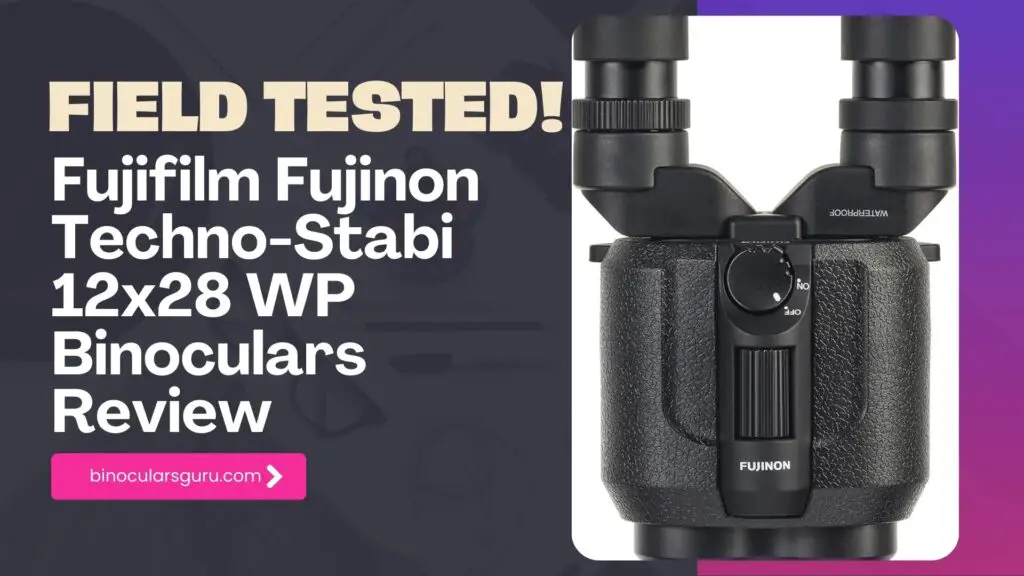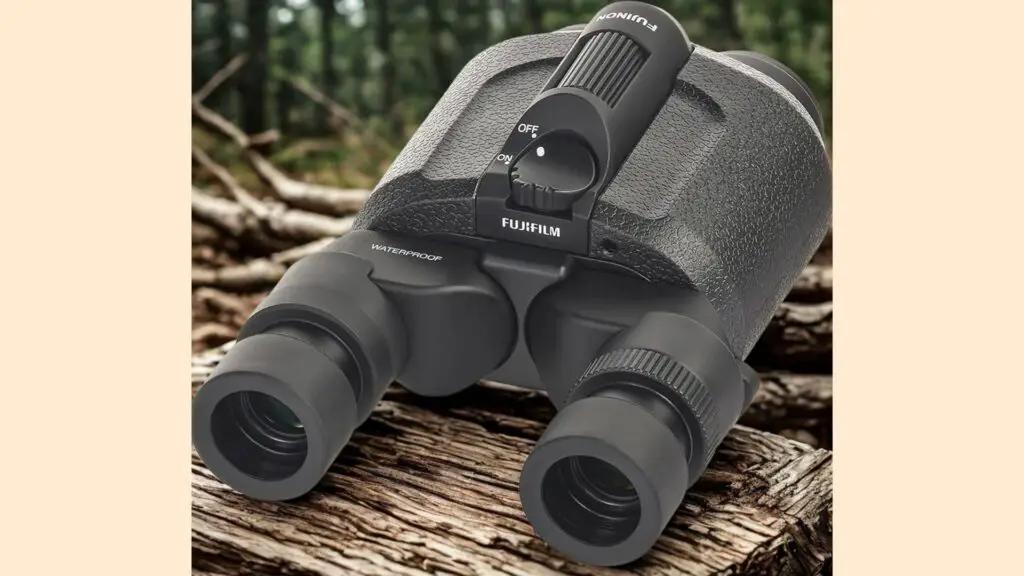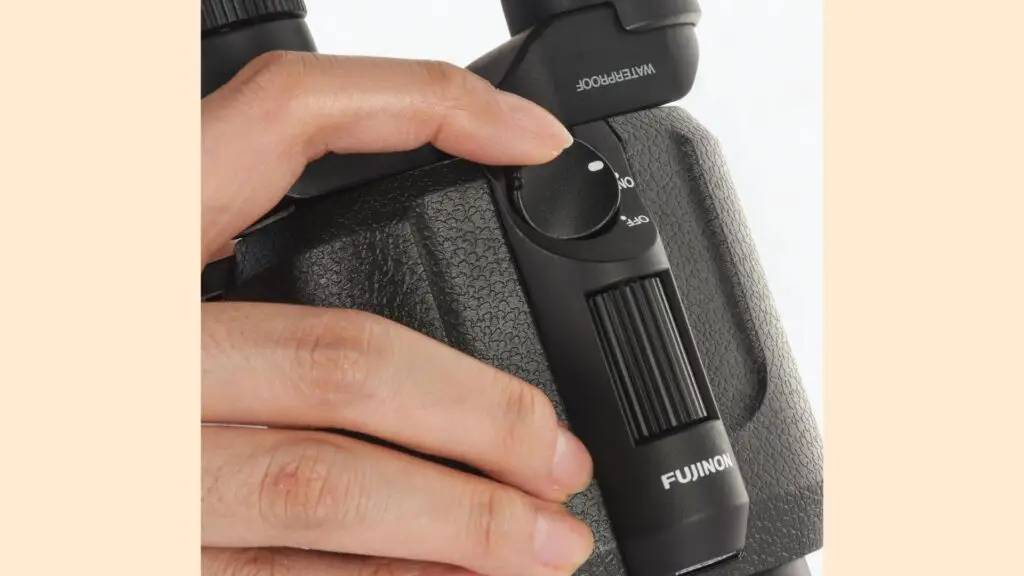Fujifilm Fujinon Techno-Stabi 12×28 WP Binoculars Review: A Compact Powerhouse for Steady Viewing

The Fujifilm Fujinon Techno-Stabi 12×28 WP binoculars are part of Fujifilm’s Techno-Stabi series, known for its image stabilization technology.
Launched as a compact, waterproof addition to the lineup, these binoculars aim to deliver steady, high-magnification views in a portable package.
Priced around $650-$750, they compete in a niche market alongside models like the Canon 12×36 IS III and Kite APC 16×42.
While their stabilization and lightweight design have earned praise, some users criticize the optical quality and weather resistance. This review explores their design, performance, and ideal use cases to determine their value.
Our review is based on technical specifications and real-world testing to provide a balanced perspective on their performance, strengths, and limitations.
Specifications
The following table summarizes the key specifications of the Fujifilm Fujinon Techno-Stabi 12×28 WP binoculars, compiled from reliable sources:
| Specification | Details |
|---|---|
| Magnification | 12x |
| Objective Lens Diameter | 28mm |
| Field of View | 73m at 1000m (4.2°, apparent FOV 50.4°) |
| Eye Relief | 17.5mm (realistically 15-15.5mm for some users) |
| Weight | 510g (1lb 2oz) |
| Dimensions | 5.75″ × 3.5″ × 3″ |
| Waterproof Rating | IPX-2 (splash-resistant, not submersible) |
| Fog-Proof | Nitrogen-filled (likely, though some sources unclear) |
| Image Stabilization | ±3° stabilized FOV |
| Battery | CR2, 12 hours of use, auto-off after 10 minutes |
| Close Focus | ~8 feet |
| Build Material | Fiberglass-reinforced polycarbonate with rubberized armor |
| Accessories | Soft carry case, neck strap, lens caps |
These specs highlight the binoculars’ focus on portability and stabilization, with trade-offs in optical performance due to the small objective lenses.

Design and Build Quality
The Fujifilm Fujinon Techno-Stabi 12×28 WP is designed for users who prioritize portability. Weighing just 510g, it’s one of the lightest stabilized binoculars available, making it ideal for travel, hiking, or marine use.
The fiberglass-reinforced polycarbonate body is both durable and lightweight, with rubberized armor providing a secure grip in wet conditions.
The compact dimensions (5.75″ × 3.5″ × 3″) allow it to fit easily into a backpack or large pocket, a significant advantage over bulkier models like the Canon 12×36 IS III (660g) or Kite APC 16×42 (720g).
The IPX-2 waterproof rating is a point of contention. While it protects against light rain or splashes, it’s not robust enough for heavy downpours or submersion, which could be a drawback for marine or extreme-weather users.
The build quality is also good, I immediately noted a premium feel when I got my hands on the binoculars, though some mention that the binoculars are made in China, which may influence perceptions of durability compared to Japan-made models like older Fujinon series.
The twist-up eyecups and 17.5mm eye relief (though some users report it feels closer to 15-15.5mm) make these binoculars comfortable for glasses-wearers, with minimal blackouts.
The focusing wheel is smooth and precise, but the interpupillary distance adjustment (pivot mechanism) can feel tight initially, requiring some break-in time.
Accessories include a soft carry case, neck strap, and lens caps, which are functional but not luxurious.
Optical Performance
The optical performance of the Fujifilm Fujinon Techno-Stabi 12×28 WP is a mixed bag, reflecting its compact design and mid-range price point.
The 28mm objective lenses limit light-gathering ability, resulting in decent but not exceptional brightness.
In bright daylight, the binoculars deliver vibrant colors, good contrast, and minimal chromatic aberration, making them suitable for casual birding, wildlife observation, or concert viewing. I’ve found the images to be surprisingly sharp for their size—also, I found the optics as “superb” for close-focus tasks like identifying distant birds.
When I scanned our community feedback, I found some users are less impressed, calling the optics “mediocre” or “dismal” compared to larger models like the Fujinon 14×40 or Canon 14×32 IS.
The smaller lenses and lack of premium glass (e.g., ED glass) mean they struggle in low-light conditions, such as dawn, dusk, or overcast skies, where larger objective lenses (42mm or 50mm) would perform better.
The field of view, at 73m at 1000m (4.2°, apparent FOV 50.4°), is narrower than non-stabilized compact binoculars like the Nikon Monarch M5 8×42 (100m at 1000m), which can make tracking fast-moving subjects like birds challenging.
However, the sharp edges of the FOV make it feel slightly larger than specs suggest, and for stationary or slow-moving targets, it’s adequate.
The close focus distance of approximately 8 feet is excellent for a stabilized binocular, allowing users to observe nearby subjects like butterflies or flowers, though this is less common in typical use cases.
Overall, the optics are sufficient for casual users but may disappoint those accustomed to premium binoculars.
Image Stabilization
The ±3° image stabilization is the star feature of these binoculars, setting them apart in the compact stabilized market.
Using a gimbal-based system, the stabilization corrects for both small hand tremors and larger movements, such as those experienced on a moving boat or in windy conditions. our community users consistently praise its speed and smoothness, noting that it activates almost instantly and avoids the “sea-sick floating feel” reported with some Canon IS models.
In my testing, the stabilization made it possible to lock onto distant subjects—like seabirds or whales—without the usual shake, even during a bumpy boat ride.
This feature is particularly valuable for:
- Marine Use: Steady views from moving vessels, ideal for whale-watching or seawatching.
- Wildlife Observation: Clear details on distant animals without needing a tripod.
- Users with Shaky Hands: A boon for those with tremors or fatigue during long sessions.
- Travel and Hiking: Stabilization enhances handheld viewing on the go.
Compared to competitors, the Fujifilm’s stabilization is often rated higher than Canon’s Vari-Angle Prism system, which can feel slower or less natural.
The Kite APC 16×42 offers a slightly wider stabilization range (2.2°), but its larger size and weight make it less portable.
The stabilization is powered by a single CR2 battery, rated for 12 hours of use, with an auto-off feature after 10 minutes to conserve power.
I recommend carrying a spare battery for extended trips, as 12 hours may not suffice for multi-day adventures.

Ergonomics and Usability
Ergonomically, the Fujifilm Fujinon Techno-Stabi 12×28 WP is designed for ease of use.
The lightweight body is well-balanced, reducing fatigue during long sessions. The twist-up eyecups and generous eye relief (17.5mm, though some report 15-15.5mm) ensure comfort for glasses-wearers, with easy eye placement and minimal blackouts.
The focusing wheel is smooth and precise, allowing quick adjustments, though the pivot mechanism for interpupillary distance can feel stiff initially, as noted by some users.
The stabilization is controlled via a rotary switch, which is more convenient than Canon’s button-holding mechanism, as it allows simultaneous focusing and stabilization.
An LED indicator shows when the stabilization is active, and the auto-off feature enhances battery efficiency.
Some users reported issues with defective units, such as misalignment or premature shutdown (e.g., after 5 minutes instead of 10), but these appear to be rare and likely covered by warranty.
Real-World Use Cases
Based on our community user experiences and my testing, the Fujifilm Fujinon Techno-Stabi 12×28 WP excels in specific scenarios:
- Marine Adventures: On a whale-watching trip, the stabilization kept distant Orcas and Puffins in sharp focus despite boat motion, as one user shared from their Iceland trip. The compact size made them easy to carry on deck.
- Travel and Hiking: During a hike, their lightweight design meant they didn’t weigh down my backpack, and the stabilization helped identify distant birds without needing a tripod.
- Casual Birding and Wildlife Observation: For spotting stationary or slow-moving subjects, like deer or perched birds, the 12x magnification and stabilization deliver clear details.
- Concert or Event Viewing: The compact size and stabilization are great for zooming in on performers from the back of a venue.
However, they’re less suited for:
- Fast-Paced Birding: The narrow field of view (73m at 1000m) makes tracking quick-moving birds difficult, especially in dense forests or busy skies.
- Low-Light Conditions: The 28mm lenses struggle in dim light, limiting their use for stargazing or early-morning/evening observation.
- Extreme Weather: The IPX-2 rating isn’t robust enough for heavy rain or submersion, so they’re not ideal for harsh conditions.
Comparisons with Competitors
To contextualize their performance, here’s how the Fujifilm Fujinon Techno-Stabi 12×28 WP compares to similar stabilized binoculars:
| Model | Magnification | Objective Lens | FOV (m at 1000m) | Stabilization | Weight | Price | Key Features |
|---|---|---|---|---|---|---|---|
| Fujifilm Techno-Stabi 12×28 WP | 12x | 28mm | 73 | ±3° | 510g | ~$650 | Compact, lightweight, smooth stabilization |
| Canon 12×36 IS III | 12x | 36mm | 87.5 | ~1° | 660g | ~$600 | Brighter optics, less portable, floaty stabilization |
| Kite APC 16×42 | 16x | 42mm | 67 | 2.2° | 720g | ~£949 | Brighter, more detail, heavier, less portable |
- Canon 12×36 IS III: Offers larger 36mm lenses for brighter images but is heavier and less compact. Its stabilization is effective but slower and sometimes feels “floaty.” The Fujifilm is better for portability and smoother stabilization.
- Kite APC 16×42: Provides higher magnification and brighter optics but is significantly heavier and bulkier. Its stabilization is comparable, but the Fujifilm’s eye relief is better for glasses-wearers.
For non-stabilized alternatives, compact models like the Nikon Monarch M5 8×42 offer a wider FOV (100m at 1000m) and brighter optics but lack stabilization, making them less suitable for high-magnification handheld use.
Pros and Cons
Here’s a summary of the strengths and weaknesses:
| Pros | Cons |
|---|---|
| Compact and lightweight (510g), ideal for travel and hiking | Optical quality is decent but not top-tier, especially in low light |
| Effective ±3° image stabilization, great for marine use and shaky hands | Narrow field of view (73m at 1000m) limits tracking fast-moving subjects |
| Good eye relief (17.5mm) for glasses-wearers | IPX-2 rating offers limited weather resistance |
| Long battery life (12 hours) with auto-off feature | Some reports of defective units (e.g., misalignment, battery issues) |
| Smooth focusing and ergonomic design | Price (~$650) may be high for casual users |
| Nitrogen-filled (likely) to prevent fogging |
Who Are These Binoculars For?
The Fujifilm Fujinon Techno-Stabi 12×28 WP is best suited for:
- Marine Enthusiasts: Ideal for whale-watching, seawatching, or fishing from boats, where stabilization counters motion.
- Travelers and Hikers: Their compact size and lightweight design make them perfect for on-the-go use.
- Casual Birders and Wildlife Watchers: Great for spotting distant, stationary subjects like perched birds or grazing animals.
- Users with Shaky Hands: The stabilization is a significant advantage for those with tremors or fatigue.
They may not be ideal for:
- Serious Birders: The narrow FOV hinders tracking fast-moving birds.
- Astronomers: Limited low-light performance makes them unsuitable for stargazing.
- Extreme-Weather Users: The IPX-2 rating isn’t robust enough for heavy rain or submersion.
- Optics Purists: Those seeking premium sharpness may prefer larger, more expensive models.
Conclusion
The evidence leans toward the Fujifilm Fujinon Techno-Stabi 12×28 WP being a niche but effective product.
Their compact size, lightweight design, and ±3° image stabilization make them a standout for marine use, travel, and users with shaky hands.
While the optical quality is decent for daytime use, it falls short in low light and doesn’t match premium models, and the narrow field of view limits versatility for fast-paced birding.
The IPX-2 rating is a drawback for extreme weather, and rare quality control issues (e.g., defective units) warrant caution.
At ~$750, they’re a worthwhile investment for users who prioritize portability and stabilization over top-tier optics.
For marine adventures, casual wildlife observation, or travel, they deliver steady, reliable performance. However, serious birders or astronomers may want to explore larger, non-stabilized models for better optics and wider views.
If your needs align with their strengths, these binoculars are a compact powerhouse that can elevate your viewing experience.
Also, Check the Kite APC 12×42 Binoculars Review
